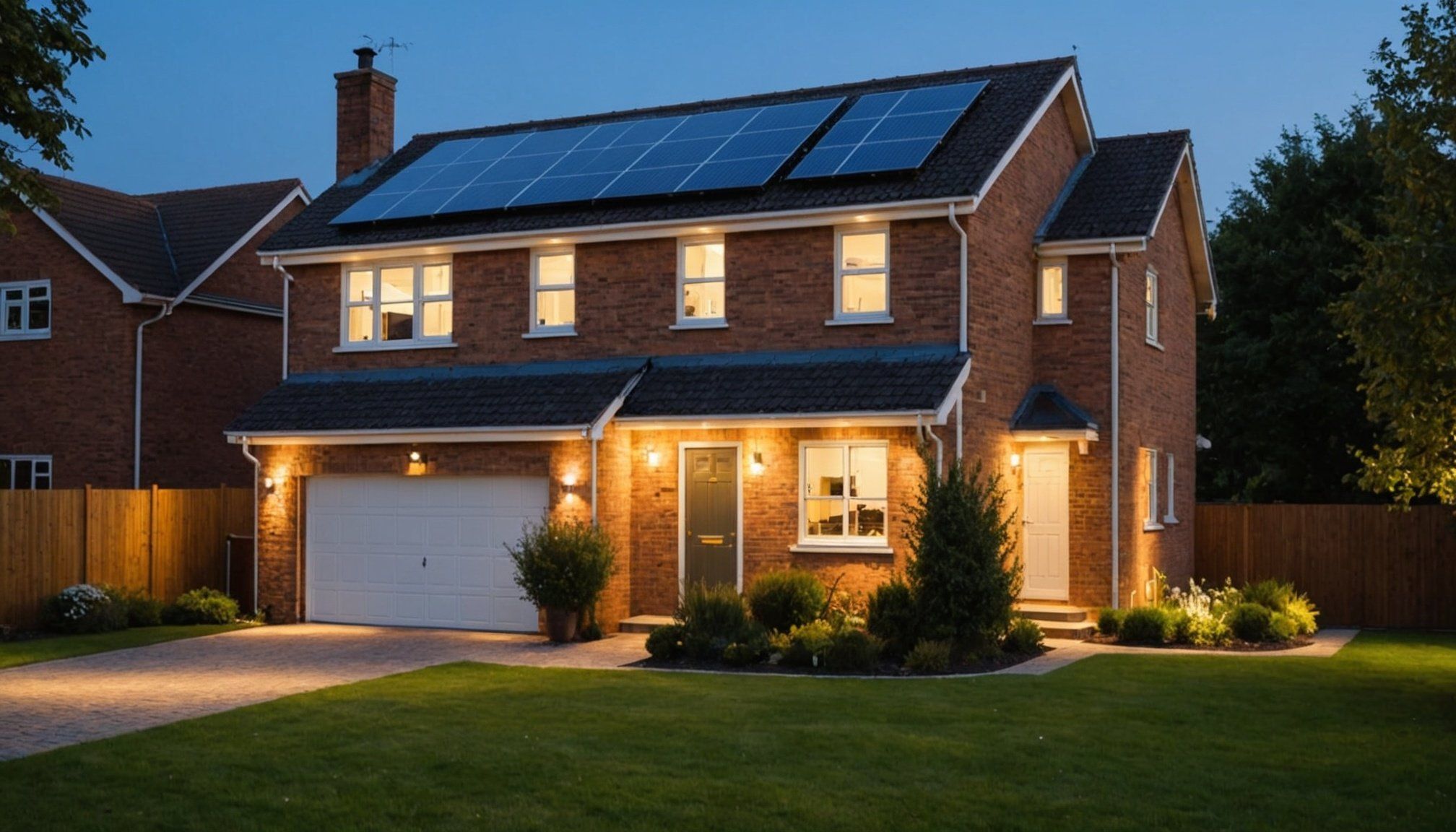Understanding Solar Lighting Systems
Solar lighting systems have emerged as a popular option for those seeking eco-friendly lighting solutions to illuminate outdoor spaces. These systems consist of several components: solar panels, which absorb sunlight and convert it into electricity; a battery, storing the generated power; and LED bulbs, which provide the illumination. Furthermore, a smart controller manages the energy usage efficiently.
One of the most significant advantages of employing outdoor solar solutions is their environmental benefit. Unlike traditional lighting systems, solar-powered lights do not contribute to greenhouse gas emissions. They rely solely on renewable energy, reducing dependency on fossil fuels and lowering the carbon footprint.
Also to discover : Explore the benefits of insulated products for every lifestyle
In terms of application, outdoor solar solutions have a variety of uses in UK gardens. From illuminating pathways and driveways to beautifying garden landscapes, these systems enhance safety while adding aesthetic value. Serenity and visibility are maintained without the hassle of wiring or incurring electricity costs. Additionally, solar-powered lights are resilient to changing weather conditions, a necessity for the varying UK climate.
By choosing solar lighting systems, homeowners invest in a sustainable and cost-effective solution that aligns with modern environmental standards and enhances outdoor spaces.
Have you seen this : Top Budget-Friendly Smart Home Leak Detection Sensors for UK Houses: A Comprehensive Guide
Designing Your Eco-Friendly Solar Lighting System
Embarking on the journey to install solar lighting in your outdoor area involves more than simply placing lights where you desire. A thoughtful design is essential for achieving the ideal balance between outdoor aesthetics and garden security.
Assessing Your Space
To begin, analyze your garden layout to determine the existing lighting needs. Consider how natural light interacts with shaded areas to identify spots that require enhancement. Pay special attention to key areas such as pathways, entrances, and secluded corners to maximize security enhancement. This strategic assessment helps in highlighting critical spots that need lighting.
Incorporating aesthetics can seamlessly blend your solar lighting system into the landscape. Choose designs that complement your garden’s character, whether it be modern minimalist or charming cottage style. Aim for a harmonious look, ensuring that security features do not compromise the visual appeal.
Selecting the Right Solar Lights
There are various types of solar lights suitable for outdoor use, each serving different purposes. For enhanced garden security, motion-sensor lights are ideal. Meanwhile, decorative lights, string lights, or lamp posts enhance aesthetic integration. Look for features like battery life, brightness, and weather resistance in eco-friendly solar lights to ensure longevity and efficiency. Brands like SunForce and Gama Sonic are renowned for providing reliable and enduring solar solutions.
Installation of Solar Lighting Systems
Embarking on a DIY solar installation journey can be both rewarding and cost-effective. The process begins with selecting a suitable location. Solar lights thrive with direct sunlight, so ensure your chosen spot isn’t shaded by trees or structures.
Step-by-Step Guide to Installing Solar Lights
-
Assess the Area: Identify locations with the most sunlight exposure. Use a compass to determine the south-facing direction for maximum efficiency.
-
Prepare the Ground: Firmly secure the solar light stakes into the soil. Ensure the ground is level to prevent tilting.
-
Assemble the Light Fixtures: Follow the manufacturer’s instructions carefully. Most solar lights have simple assembly steps.
-
Charge the Batteries: Before using, allow the solar lights to charge for at least 12 hours in sunlight. This maximises their lifespan and performance.
Tips for Effective Positioning and Placement
- Avoid placing lights near artificial light sources, which can confuse the sensor.
- Place lights around 6 to 8 feet apart for uniform illumination.
Common Mistakes to Avoid
- Overlooking UK installation guidelines: Ensure compliance with local laws for optimal safety.
- Ignoring maintenance: Regularly clean solar panels to remove debris or dust, as this affects performance.
UK Climate Considerations
The UK weather presents a unique set of challenges for solar energy efficiency which impacts both performance and setup. While the typical climate includes ample cloud cover, solar light systems can still be effective if optimally designed. The key lies in understanding and adapting to these conditions.
Seasonal factors significantly influence solar performance. During winter, reduced daylight hours and increased cloudiness can diminish efficiency. However, the use of advanced solar panel technology and energy storage solutions can enhance performance even in these less favourable conditions. By utilising battery storage, any excess energy generated on sunnier days can be stored for use during shorter, cloudier winter days.
To maximise solar light efficiency year-round, it’s crucial to consider optimal panel positioning. Ideally, solar panels should be tilted at an angle equal to the latitude of the installation site, ensuring they capture the most sunlight possible. Regular maintenance is also essential, including keeping panels clear of debris and monitoring for any faults.
By addressing these seasonal challenges, individuals can harness the power of solar energy even in less than ideal weather conditions, making it a viable option throughout the year in the UK.
Benefits of Eco-Friendly Solar Lighting
Harnessing solar lighting offers significant environmental advantages, promoting sustainability and energy conservation. These lights derive energy directly from the sun, minimizing reliance on non-renewable sources. This translates to reduced carbon emissions, a compelling environmental benefit.
Incorporating solar lighting contributes to substantial energy savings. Traditional lighting relies heavily on electricity, often generated through fossil fuels, while solar options operate independently of the power grid. Solar units can drastically decrease monthly utility expenses, delivering substantial savings over time. Initial installation costs can be offset by these ongoing savings.
Moreover, cost-effectiveness is a hallmark of solar lighting solutions. Unlike conventional lighting which incurs regular electricity charges, solar systems harness free, renewable solar energy. With technology advancements, solar lighting systems have become more affordable and efficient.
Investing in solar lighting enhances property value, demonstrating a commitment to sustainable practices. Buyers often appreciate eco-friendly features, and properties equipped with solar solutions can stand out in the market. This shows a forward-thinking, environmentally conscious approach to home and business management.
Implementing solar lighting empowers property owners to contribute to environmental preservation, while also realising personal and financial gains. This makes it a wise, sustainable choice for modern development.
Case Studies and Successful Installations
Solar lighting has transformed various spaces, providing both eco-friendly and aesthetic solutions. Let’s explore some notable examples that inspire design ideas for successful solar lighting installations.
Residential Installations
In the UK, homeowners have embraced solar lighting as a sustainable option to enhance their properties. A popular choice includes pathway lights, which not only illuminate walkways but also add charm to garden paths. Homeowners often highlight their ease of installation and the absence of electricity costs as key advantages. Feedback indicates their satisfaction with the combination of functionality and aesthetic appeal.
Another compelling feature reported is the versatility of solar spotlights. Positioned to highlight architectural features or garden elements, these lights serve as night-time focal points without being intrusive. Such design inspirations elevate the approach to residential outdoor spaces, showcasing that eco-friendliness doesn’t compromise style.
Community and Public Spaces
Public parks and community areas have seen successful solar lighting implementations. In many parks, solar lamps contribute significantly to community safety by providing consistent illumination. Additionally, the collaborations between local authorities and residents have resulted in energy-efficient projects that boost both security and communal pride. These initiatives also support aesthetic improvements that promote a sense of unity and environmental responsibility, demonstrating the manifold benefits of harnessing solar power for lighting.











